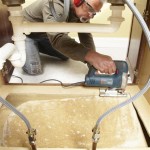Best Kitchen Cabinet Cleaner For Wood: Choosing the Right Solution
Maintaining the beauty and longevity of wood kitchen cabinets requires consistent cleaning and care. Over time, cabinets accumulate grease, grime, dust, and food splatters, diminishing their aesthetic appeal and potentially damaging the wood finish. Selecting the appropriate cleaner is crucial for effectively removing these build-ups without causing harm. This article explores factors to consider when choosing a wood cabinet cleaner and highlights some of the best options available.
Understanding Different Types of Wood Finishes
Before selecting a cleaner, it is essential to identify the type of finish applied to the wood cabinets. Common finishes include varnish, lacquer, polyurethane, paint, and oil-based finishes. Each type reacts differently to various cleaning agents. Using the wrong cleaner can lead to discoloration, peeling, cracking, or a dulling of the finish. For example, abrasive cleaners can scratch varnish, while harsh solvents can dissolve lacquer. Always consult the manufacturer's instructions for the specific cabinet finish, if available.
Cabinets with a polyurethane finish are generally durable and resistant to many cleaners, but it's still best to avoid harsh chemicals. Painted cabinets require gentle cleaning to prevent chipping or fading. Oil-based finishes typically benefit from cleaners containing oils that replenish the wood. Older cabinets, especially those with unknown finishes, should be tested in an inconspicuous area before applying any cleaner to the entire surface.
Knowing the finish will guide the selection process and prevent irreversible damage. Identifying the finish may involve contacting the cabinet manufacturer, checking original documentation, or consulting with a professional wood finisher.
Key Ingredients and Their Impact on Wood Cabinets
The ingredients in a cabinet cleaner play a significant role in its effectiveness and safety. Understanding the function of different components can aid in making an informed decision. Common ingredients include surfactants, solvents, pH adjusters, fragrances, and preservatives. Surfactants help to lift dirt and grease from the surface of the wood, while solvents dissolve stubborn stains.
Cleaners with a neutral pH are generally safer for wood surfaces, as highly acidic or alkaline solutions can damage the finish. However, some specialized cleaners may require a specific pH level for optimal performance in addressing particular stains or grime. It is crucial to carefully read the ingredient list and product description to understand the cleaner's formulation and potential effects.
Avoid cleaners containing harsh chemicals like ammonia, bleach, or strong abrasives. These can strip the finish, discolor the wood, or leave behind a residue. Instead, opt for cleaners specifically formulated for wood, with gentle, biodegradable ingredients. Natural ingredients like vinegar, olive oil, and lemon juice can be effective cleaning agents when used correctly.
Top Cleaner Recommendations and Their Applications
Several excellent wood cabinet cleaners are available on the market, each designed to address different cleaning needs. Consider the following options based on the type of cleaning required and the characteristics of the wood finish.
1. Murphy Oil Soap
Murphy Oil Soap is a classic choice for cleaning wood surfaces. This product is formulated with natural oils that help to clean and condition the wood simultaneously. Its gentle formula is suitable for a wide range of wood finishes, including polyurethane, varnish, and painted surfaces. It is particularly effective at removing everyday dirt and grime without stripping the finish. To use Murphy Oil Soap, dilute it in warm water according to the manufacturer's instructions and apply it with a soft cloth. Wipe the cabinets thoroughly and then dry them with a clean cloth.
While generally safe, testing Murphy Oil Soap in an inconspicuous area, especially on older or unknown finishes, is advisable. Some users report that it can leave a slight residue if not properly diluted or if too much product is used. Proper rinsing and drying are essential to prevent build-up.
2. Method All-Purpose Cleaner
Method All-Purpose Cleaner is a plant-based cleaner that is both effective and environmentally friendly. It is available in various scents and is formulated without harsh chemicals like ammonia or bleach. While not specifically designed for wood, its gentle formula makes it suitable for cleaning lightly soiled wood cabinets with durable finishes. Test first in an inconspicuous area to ensure compatibility.
Method cleaner is easy to use; simply spray it onto a soft cloth and wipe the cabinets. Its non-toxic formula makes it safe for use around children and pets. However, it may not be as effective at removing heavy grease or stubborn stains as other cleaners specifically designed for wood.
3. Weiman Wood Cabinet Cleaner & Polish
Weiman Wood Cabinet Cleaner & Polish is specifically formulated to clean and protect wood cabinets. This product not only removes dirt, grease, and fingerprints but also polishes the wood surface, leaving behind a protective layer. It is suitable for various wood finishes, including painted, varnished, and laminated cabinets. Weiman Wood Cabinet Cleaner & Polish contains ingredients that help to restore the wood's natural shine and prevent it from drying out.
To use Weiman Wood Cabinet Cleaner & Polish, spray it onto a soft cloth and wipe the cabinets in the direction of the wood grain. Buff the surface with a clean cloth to achieve a polished finish. This product is particularly beneficial for cabinets that require regular cleaning and maintenance, as it helps to protect them from future damage.
4. Homemade Vinegar Solution
A homemade solution of vinegar and water can be an effective and economical way to clean wood cabinets. Vinegar is a natural degreaser and disinfectant that can help to remove dirt, grime, and odors. To make a vinegar solution, mix equal parts white vinegar and warm water in a spray bottle. Spray the solution onto a soft cloth and wipe the cabinets, being careful not to saturate the wood. Dry the cabinets with a clean cloth.
While generally safe, vinegar can be acidic and potentially damage some wood finishes. Always test the solution in an inconspicuous area before applying it to the entire surface. Adding a few drops of essential oil, like lemon or orange, can help to mask the vinegar smell and add a pleasant fragrance.
5. Howard Products Feed-N-Wax Wood Preserver
Howard Products Feed-N-Wax Wood Preserver is specifically designed to nourish and protect wood surfaces. This product contains a blend of beeswax, carnauba wax, and orange oil, which work together to clean, polish, and condition the wood. It is particularly beneficial for cabinets with oil-based finishes or those that are prone to drying out. Howard Feed-N-Wax penetrates the wood, replenishing its natural oils and preventing it from cracking or splitting.
To use Howard Feed-N-Wax, apply a thin coat to the cabinets with a soft cloth, working it into the wood grain. Allow it to penetrate for a few minutes, then buff the surface with a clean cloth. This product is ideal for maintaining the beauty and longevity of wood cabinets, especially those in high-use areas.
Essential Cleaning Techniques and Best Practices
Regardless of the cleaner chosen, employing proper cleaning techniques is crucial for achieving optimal results and preventing damage to the wood cabinets. Follow these best practices for cleaning wood kitchen cabinets:
- Dust Regularly: Before cleaning, dust the cabinets with a soft cloth or brush to remove loose dirt and debris. This prevents the cleaner from simply spreading the dust around and ensures a more effective cleaning process.
- Avoid Over-Saturating: When applying a cleaner, use a lightly damp cloth. Avoid saturating the wood, as excessive moisture can seep into the pores and cause warping or discoloration.
- Wipe in the Direction of the Grain: Always wipe the cabinets in the direction of the wood grain. This helps to prevent streaks and ensures a more even cleaning.
- Rinse Thoroughly: If the cleaner requires rinsing, use a clean, damp cloth to remove any residue. This is particularly important for cleaners with a high concentration of surfactants or solvents.
- Dry Immediately: After cleaning and rinsing, dry the cabinets with a clean, dry cloth. This prevents water spots and helps to maintain the wood's natural shine.
- Test in an Inconspicuous Area: Before applying any cleaner to the entire surface, test it in an inconspicuous area, such as the inside of a cabinet door or a hidden corner. This allows to assess its compatibility with the wood finish and prevent any unexpected damage.
- Use Separate Cloths: Use separate cloths for cleaning, rinsing, and drying to avoid reintroducing dirt or residue to the cabinets.
- Address Spills Promptly: Clean up spills and splatters as soon as they occur to prevent them from setting in and becoming more difficult to remove.
By following these techniques and selecting the appropriate cleaner, wood kitchen cabinets can be kept looking their best for years to come.
Frequency of Cleaning and Maintenance Schedule
The frequency with which wood cabinets should be cleaned depends on various factors, including the level of use, exposure to grease and splatters, and the type of finish. As a general guideline, cabinets should be dusted weekly to remove loose dirt and debris. A more thorough cleaning should be performed every one to three months, or as needed.
Cabinets in high-use areas, such as those near the stove or sink, may require more frequent cleaning. Grease and splatters can quickly accumulate on these surfaces, necessitating more regular attention. Cabinets with light-colored finishes may also require more frequent cleaning, as dirt and stains are more visible.
In addition to regular cleaning, wood cabinets should also be maintained with appropriate polishes or conditioners. These products help to protect the wood from moisture, UV damage, and scratches. Apply a wood polish or conditioner every six to twelve months, or as recommended by the manufacturer of the finish.
Establishing a consistent cleaning and maintenance schedule can help to keep wood cabinets looking their best and prolong their lifespan. Regularly dusting, cleaning, and polishing the cabinets will prevent dirt and grime from building up and causing permanent damage.

Cabinet Wood Cleaner

How To Clean Wood Kitchen Cabinets And The Best Cleaner For Job

Almond Glo Kitchen Cabinet Cream 12 Oz

Goddard S Cabinet Makers Wax Cleaning Spray Wood Cleaner Furniture Polish To Shine Protect W Bee Lemon Oil For

We Tried 5 Methods To Clean Greasy Wood Cabinets And The Winner Is Ridiculously Effective Kitchn

Best Approach To Cleaning Wood Kitchen Cabinets Touch Of Oranges

Before You Use Guardsman Wood Cleaner Watch This

Best Wood Cabinet Cleaners Cabinetdoors Com

Best Natural Ways For Cleaning Wood Cabinets

7 Best Kitchen Cabinet Cleaners For A Spotless Shine
Related Posts








